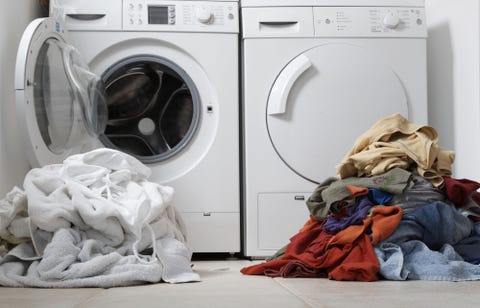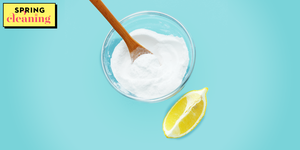It’s hard to find the perfect white t-shirt, there’s no doubt about that — which is why it’s a real bummer when you realize your favorite shirt has seen better days. But before you toss or donate it, follow the advice below from Carolyn Forte, director at the Good Housekeeping Institute Cleaning Lab, on how to use bleach to refresh faded clothes in the wash. But first, take note: Before using bleach on a garment, always check the care label. If it says “no bleach,” that means (you guessed it!) no bleach — not even all-fabric bleach is safe to use.
How to Bleach Clothes
- The first time you use bleach on an item, it’s best to do a spot test in a hidden location first (like the inside of a collar or cuff) to make sure it’s safe.
- Once you’ve determined your item is safe, we recommend soaking your item before washing it if it’s heavily soiled or stained. But it’s worth noting that most whites, if washed often, don’t need to be pre-soaked. It you still want to pre-soak, check your machine — many have a dedicated pre-soak cycle you can select.
- Add bleach separately to your washer’s timed bleach dispenser, then run your wash cycle as usual. If you’re using an all-fabric or oxygen color-safe bleach, like OxiClean Versatile Stain Remover, you can add it at the start of the cycle according to the manufacturer’s instructions. For liquid chlorine bleach, like Liquid Clorox Bleach, add the amount instructed by the manufacturer through the machine’s detergent dispenser five minutes into the cycle. “Chlorine bleach gets added five minutes into the cycle in order to give the enzymes in your detergent a chance to remove stains,” says Forte.”Add chlorine bleach at the beginning and it kills the detergent’s enzymes before they have a chance to work.”
- Dry your item as normal.
How to Prevent White Clothes From Fading
1. Wash items after every one to two wears.
Even if you can’t see them, invisible body soils and perspiration can turn white fabrics yellow or gray over time. “You want to wash them out before they build up,” says Forte.
2. Attack stains as soon as possible.
Food spots like ketchup or coffee are a given, but things that you can’t see, like sweat marks, should be treated to prevent build-up too. To do this, rub a full-strength liquid enzyme detergent, like Tide Total Care Renewing Rain Scent Liquid Laundry Detergent on the underarm area, then let your shirt sit 15 minutes before throwing it into the wash.
3. Always separate white and colored clothes.
Sure, this seems obvious, but it really makes a difference, according to Forte: “This is a must!” If you wash whites and lights together, use a dye-grabbing cloth like Carbona Color Grabber to attract loose dye in your load and keep the color from settling on your whites.
4. Pick a laundry detergent that contains bleach.
Or bleach alternatives. Forte says these products generally get whites whiter during the washing cycle. Another cleaner that you might want to try is a bluing agent, like Mrs. Stewart’s Bluing which make fabrics look blue-white instead of yellow-white.
5. Be exact when measuring cleaner.
“Overuse or underuse of detergent can leave fabrics gray and dingy,” explains Forte. That’s because suds cushion fabrics and dirt, so stains get trapped and don’t wash away like they should. Bottom line: just follow the instructions on your bottle.
6. Don’t overload your washing machine.
We know, when there’s space at the top it’s hard to resist throwing in a few more shirts, but Forte says you should resist: “Clothing needs to circulate to get clean.” If you fill your washtub to the top, there isn’t enough room for the detergent to interact with soils and give an optimal cleaning performance.
7. Use the hottest water safe for fabric.
“The hotter the water, the more germs you kill,” says Forte. Higher temperatures also remove more soil, which is what causes white items to fade over time. But to prevent shrinkage and damage to clothes, check the care label to see just how hot you can go.
8. Dry clothes according to the care label.
According to Forte, over-drying will make your wardrobe look more worn over time, so pick your setting according to the label. Another option? “Use the auto cycle so the dryer stops when it senses the clothing is dry, not just when the time is up,” Forte says.
9. Try out these no-stain faves.
The Cleaning Lab tested buzzy, “no-stain” fabrics and picked out these two winners. Water-based liquids like red wine and hot coffee rolled right off the Elizabeth & Clarke blouse’s viscose fabric. Old Navy’s Stay-White jeans shed water-based spills like coffee, red wine, cola, and even soy sauce with ease.
10. Don’t forget to use these tricks on other white laundry.
That means crisp bed sheets and fluffy towels.
Source: Home Ideas - goodhousekeeping.com








